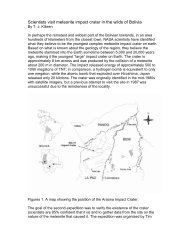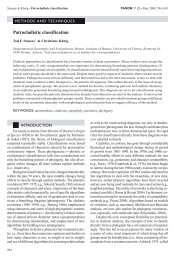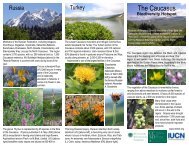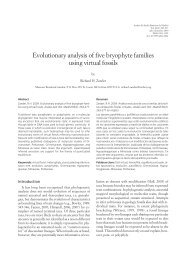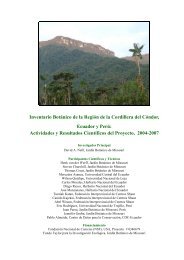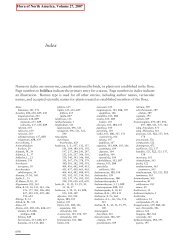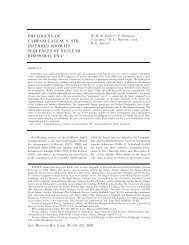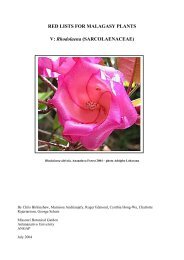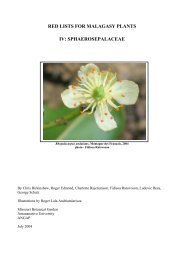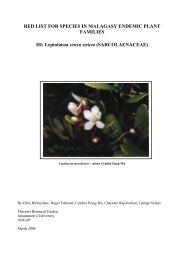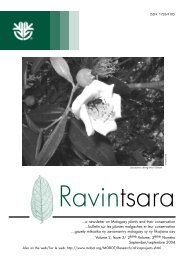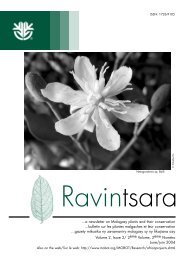re-evaluation of tortella - Missouri Botanical Garden
re-evaluation of tortella - Missouri Botanical Garden
re-evaluation of tortella - Missouri Botanical Garden
You also want an ePaper? Increase the reach of your titles
YUMPU automatically turns print PDFs into web optimized ePapers that Google loves.
eside the costa and broadly incurved above. Tortella<br />
rigens has bistratose cells juxtacostally in the median<br />
portion <strong>of</strong> the leaf and the<strong>re</strong>fo<strong>re</strong> the laminae sp<strong>re</strong>ad out<br />
in a broadly concave leaf cross section, the distal cells<br />
14 µm or mo<strong>re</strong> in width.<br />
Although Tortella rigens was not <strong>re</strong>corded as<br />
part <strong>of</strong> the Canadian moss flora by I<strong>re</strong>land et al. (1987),<br />
it does occur in the most <strong>re</strong>cent checklist <strong>of</strong> the mosses<br />
<strong>of</strong> North America north <strong>of</strong> Mexico (Anderson et al.<br />
1990). The species has p<strong>re</strong>viously been <strong>re</strong>ported from<br />
the United States for Colorado by Weber (1973), and<br />
several specimens have been collected by Hermann and<br />
determined as that species. Since all <strong>of</strong> these collections<br />
occur<strong>re</strong>d in the Rocky Mountains far from alvar<br />
substrates, it was felt necessary to examine European<br />
material to clarify the concept <strong>of</strong> the species.<br />
Specimens from Scandinavia <strong>of</strong> Tortella<br />
rigens, including authentic material identified by<br />
Albertson, we<strong>re</strong> loaned to the author from the Museum<br />
<strong>of</strong> Natural History, Stockholm (S). The specimens we<strong>re</strong><br />
compa<strong>re</strong>d with the species description as given by<br />
Nyholm (1989).<br />
R. Zander (pers. comm.) pointed out the<br />
elongate, smooth cells on the apical margins <strong>of</strong> the<br />
leaves <strong>of</strong> some plants <strong>of</strong> Tortella rigens in Swedish<br />
material—but these occur<strong>re</strong>d only on specimens with<br />
long-lanceolate leaves that showed a narrowed <strong>re</strong>gion in<br />
the apex <strong>of</strong> the leaf. Many <strong>re</strong>duced stems with<br />
cor<strong>re</strong>spondingly <strong>re</strong>duced leaves occur in these Öland<br />
and Gotland collections. Larger stems and leaves start to<br />
display an abrupt apical limb, which may be interp<strong>re</strong>ted<br />
as an apical propagulum since these a<strong>re</strong> deciduous. It is<br />
only these apical elements that a<strong>re</strong> fragile. The apical<br />
leaf <strong>re</strong>gions also have elongate smooth clear cells on the<br />
margins and, in fact, together with the stiffly e<strong>re</strong>ct<br />
leaves and tomentose stems, strongly <strong>re</strong>semble T.<br />
fragilis. (Note that these marginal cells a<strong>re</strong> f<strong>re</strong>quently<br />
eroded and not evident, but many samples exist whe<strong>re</strong><br />
they a<strong>re</strong> as distinctive as in T. fragilis.) These<br />
collections include populations with short stems and no<br />
apical diffe<strong>re</strong>ntiation, grading to long stems that a<strong>re</strong><br />
hardly distinguished from the latter species. Smaller<br />
leaves without apical modifications do not appear to be<br />
fragile at the apex.<br />
Tortella inclinata has f<strong>re</strong>quently been<br />
associated with T. fragilis through "intergrading forms"<br />
(Limpricht 1890; Dixon 1924). Tortella rigens was<br />
probably one <strong>of</strong> those forms befo<strong>re</strong> being <strong>re</strong>moved from<br />
the concept <strong>of</strong> T. inclinata. Persson (1947) indicated<br />
that Tortella rigens may have a "hybrid origin in the<br />
Postglacial" since (in Europe) it is morphologically<br />
intermediate between T. fragilis and T. inclinata. The<br />
deciduous apices and marginal cells noted above seem<br />
to substantiate this suggestion.<br />
In the few American specimens available for<br />
study, the apex may become narrowed, but so far no<br />
bordering tendency has been observed in distal portions<br />
<strong>of</strong> the leaf.<br />
Tortella rigens appears to be much mo<strong>re</strong><br />
polymorphic than one might expect from the key and<br />
42<br />
description <strong>of</strong> it given by Nyholm (1989). The<br />
species can <strong>re</strong>semble T. inclinata s.l. in having short<br />
plants with only cucullate leaves. It can <strong>re</strong>semble T.<br />
tortuosa in having lanceolate leaves that a<strong>re</strong> undulate<br />
and tipped with a short mucro. These can have<br />
anomalous leaf cross sections that a<strong>re</strong> not bistratose<br />
juxtacostally but have the large leaf cells. Taller plants<br />
can <strong>re</strong>semble T. fragilis by <strong>re</strong>ason <strong>of</strong> the fragile leaf tips<br />
<strong>of</strong> specimens with elongated leaf apices and overall by a<br />
mo<strong>re</strong> rigid leaf-stance in dry material. The stablest<br />
characters a<strong>re</strong> those that show the affinity with leaves <strong>of</strong><br />
T. inclinata s.l.: particularly the <strong>re</strong>latively naked adaxial<br />
surface <strong>of</strong> the costa, the inrolled to tubulose to cucullate<br />
leaf margins as well as the imp<strong>re</strong>ssion that the proximal<br />
cell <strong>re</strong>gion occupies less <strong>of</strong> the overall a<strong>re</strong>a <strong>of</strong> the leaf.<br />
Definitive characteristics a<strong>re</strong> the larger size <strong>of</strong> the leaves<br />
(than T. inclinata), the bistratose a<strong>re</strong>a beside the costa in<br />
leaf cross-sections <strong>re</strong>sulting in a broadly tubulose<br />
outline, and the alvar substrate. The plants a<strong>re</strong> generally<br />
taller, and <strong>of</strong> a darker g<strong>re</strong>en (less yellow) color.<br />
Specimens noted to date from North America<br />
mo<strong>re</strong> <strong>re</strong>semble the Tortella tortuosa facies in larger size<br />
and leaf characteristics, especially in undulate leaves,<br />
which a<strong>re</strong> not fragile. The leaves a<strong>re</strong> all tubulose,<br />
however, with occasional cucullate or subcucullate leaf<br />
apices, with distinctive cross sections al<strong>re</strong>ad noted<br />
(bistratose juxtacostally with large lumens beside the<br />
costa becoming sharply <strong>re</strong>duced in size toward the<br />
margins). Specimens in herbaria identified from the<br />
American and Canadian west, possibly because <strong>of</strong> an<br />
expectation that the species would <strong>re</strong>semble T. fragilis<br />
based on European material and literatu<strong>re</strong>, we<strong>re</strong> actually<br />
depauperate examples <strong>of</strong> that latter species (discussed<br />
above).<br />
Tortella inclinata is a rather small plant,<br />
occasionally attaining 15 mm in height. Plants that<br />
<strong>re</strong>semble that species, but which a<strong>re</strong> much larger<br />
overall, such as to 25 mm, and which display variable<br />
leaf apices, rather than the uniformly stubby, nearly<br />
fistulose leaves <strong>of</strong> T. inclinata, together with their<br />
association with a limestone pavement substrate, rather<br />
than gravel, sand and silt, a<strong>re</strong> most likely to be T.<br />
rigens.<br />
The observations listed in the above<br />
description <strong>of</strong> the species parallel in many <strong>re</strong>spects the<br />
Latin description <strong>of</strong> the type by Albertson (1946), which<br />
is roughly translated as follows:<br />
"Tufts robust mo<strong>re</strong> or less rigid, 1.5–3, mo<strong>re</strong><br />
ra<strong>re</strong>ly to 5 cm tall composed <strong>of</strong> stems not or little<br />
branched with <strong>re</strong>d-brown radicles loosely scatte<strong>re</strong>d.<br />
Moistened leaves e<strong>re</strong>ct-patent, dry ones strongly<br />
contorted or crisped; in young plants short, lanceolatetriangular<br />
prominently canaliculate, mitriform in the<br />
apex, matu<strong>re</strong> leaves 4–5 mm long (at the most to 6 mm,<br />
in T. inclinata normally 2–3 mm, at most 4 mm long), at<br />
least in the proximal part canaliculate oblonglanceolate,<br />
mo<strong>re</strong> or less elongate in the distal part, yet<br />
not subulate, very <strong>of</strong>ten broken, suddenly contracted.<br />
The nerve strong, in quite matu<strong>re</strong> plants usually <strong>re</strong>dbrown,<br />
in all parts distinctly separated from the cells <strong>of</strong>





